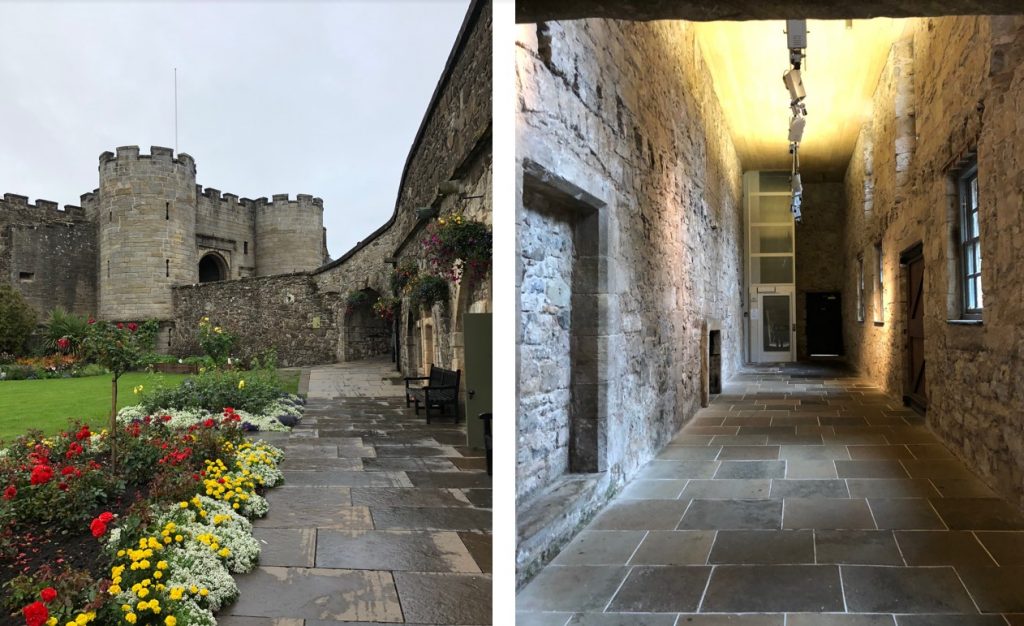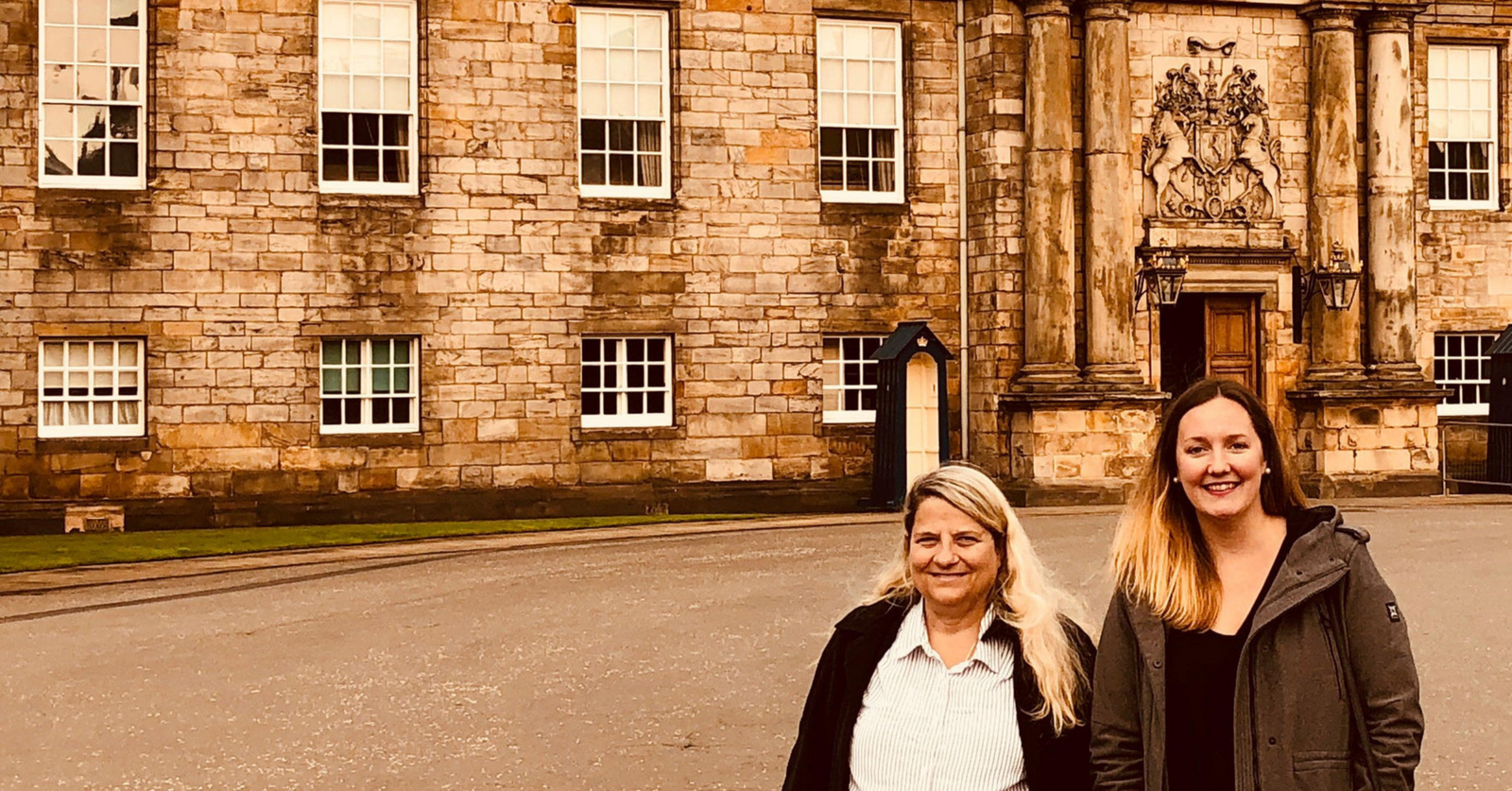Your Cart is Empty
Layers of history, breathtaking landscapes, and robust culture, Scotland is what we are dreaming of at the moment. Inspired by Betty Sullivan’s visit last September, we decided to look at features of the most prominent Scottish interiors and how they translate to our world – the world of tile. Through the centuries, the palaces, castles and everyday structures have seen so much change. From shifting monarchs, war and peace, and simple daily life, all this history has left remnants of the past.
Come with us as we jump across the pond to look at some of these portals into a time long gone. When you do, it will be easy to see why Betty, owner of Architectural Ceramics, had Scotland on her bucket list for so long.

Edinburgh is the capital of Scotland and a UNESCO World Heritage Site. Betty, her great friend Marcy and her beau Mike came with her, along with her daughter, Lisa (the one with a beer in her hand). They wanted to immerse themselves in royal history, see the pub where J.K. Rowling wrote Harry Potter, (the graveyard around the corner had the names of many of the characters she used on tombstones), find the local distilled Whisky clubs, and oh, yes, look at really old tiles. But what really enchants is the city’s charm. The stunning cityscape of the Old Town juxtaposing with the neoclassical New Town, the jutting greenery and secluded gardens, the astounding depth of history all dancing before them and around every corner. If walls could talk what stories we’d hear.

Part of Edinburgh’s beauty is due to the sandstone buildings, a large portion taken from the local Craigleith Quarry. In the 15th century, the Parliament of James I (as in King James Bible and Elizabeth’s nephew) introduced laws to primarily build in stone, alleviating the city of rampant fires from wood construction. Stone became the standard building material due to its durability and fire deterrent qualities.


We also enjoyed this fact: The stunning landscape of Edinburgh was carved from the remains of an extinct volcano that erupted millions of years ago! Want to hike to the highest point? Check out Arthur's Seat, part of Holyrood Park.
Today we can enjoy the storied buildings, from St. Margaret’s Chapel to the royal residences of Holyrood and Edinburgh Castle, and the grand squares of New Town.



One of our favorite Edinburgh hotels, The Balmoral, is an inspiration in its own right. Of course, there is a special tie to J.K. Rowling, but beyond the fame lies the beauty.

Tapestries are found all over the interiors of the finest royal residences. An integral part of medieval and renaissance interiors, they kept the frigid castle almost tolerable. Our favorite part? The tapestries even traveled with the monarch between residences, fitting in perfectly with the somewhat nomadic lifestyle of the royals at that time. Glamping at its roots.
What also kept the royals warm during the colder parts of the year? Their pets! Betty had a King Charles Cavalier dog, so naturally, she noticed a lot of paintings with this breed lying across their laps, warming them up. People and dogs had special bonds, even back then.
So what were the primary subjects of the tapestries? The woven themes were often biblical with medieval storylines, but most were stories reflecting the families’ lifestyles at the time, with hunting being a common scene.

The tapestries were such an integral part of the interior’s design that the walls were often decorated around them – commonly a painted frieze (a decorative band) would be at the top of where the tapestry would be located, with plain wall beneath where the tapestries hung.



We love the intricate details and storytelling from the elaborate works of art hanging on the walls. Tile is often a handcrafted masterpiece, inspiring us to weave together the story we wish to tell.

Many of the castles and palaces of Scotland have more to offer – all you have to do is look up. These decorative ceilings help us piece together the story of its inhabitants, evolving over time, layer by layer.

Aristocratic leisure, attention to detail, and craftsmanship. The journalist Simon Jenkins said, “To adorn a building was to respect it.” This couldn’t be truer, with brilliant and brightly colored paint, meticulous plasterwork and bold woodwork adorning the ceilings and beams. The spaces seem to say, “Why not?”. We now enjoy the expense and time spent. A feast for our eyes and more stories to decipher.



Like the ceilings we are inspired by in the Scottish castles, our very own decorative hand-painted tile is a stunning addition to a home. Wonderful for walls (and ceilings!) this tile evokes in us a feeling of warmth and materials worn with time. Lived in and loved.


Because we can’t talk about Betty’s trip without it – did we mention she got to see THE QUEEN? Yes, as in Queen Elizabeth II. And the best part is Betty was completely caught by surprise. If you look closer, you’ll see others from the Royal Family and Prince Charles in a kilt.
Enjoying the annual Braemar Gathering, checking off her bucket list “attend a Highland games” and watching athletes in kilts throw heavy objects and take part in some tug o’ war – imagine her surprise as the Queen arrives!

From building stones quarried from right beneath us to woven (and painted) stories, Scotland holds many design inspirations for today. We hope you enjoyed coming along with us on this brief journey into the past, and hopefully, found some inspiration of your own.
Now, we think it’s time to book a trip to Scotland. Who’s coming with us?
Our friendly, knowledgeable staff is always happy to help advise on tile design. Visit one of ourDC, MD, or VA tile showrooms for a free tile design consultation.
